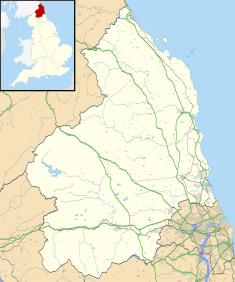
Hexham is a market town and civil parish in Northumberland, England, on the south bank of the River Tyne, formed by the confluence of the North Tyne and the South Tyne at Warden nearby, and close to Hadrian's Wall. Hexham was the administrative centre for the Tynedale district from 1974 to 2009. In 2011, it had a population of 13,097.
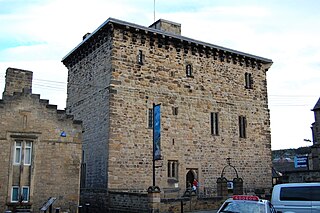
The Old Gaol, also known as the Manor Office, is a custodial building in Hallgate in Hexham, Northumberland, England. The building, which now operates as a museum, is a Grade I listed building.

Parliament House in the Old Town in Edinburgh, Scotland, is a complex of several buildings housing the Supreme Courts of Scotland. The oldest part of the complex was home to the Parliament of Scotland from 1639 to 1707, and is the world's first purpose-built parliament building. Located just off the Royal Mile, beside St Giles' Cathedral, Parliament House is also the headquarters of the Faculty of Advocates, the Society of Writers to His Majesty's Signet, and the Society of Solicitors in the Supreme Courts of Scotland. Other buildings in the complex include the Advocates Library and the Signet Library. The entire complex is a Category A Listed building.
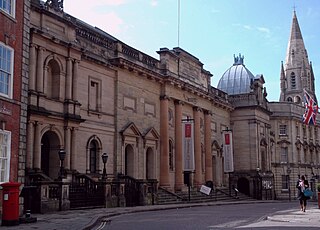
The National Justice Museum is an independent museum on High Pavement in the Lace Market area of Nottingham, England.

Hylton Castle is a stone castle in the North Hylton area of Sunderland, Tyne and Wear, England. Originally built from wood by the Hilton family shortly after the Norman Conquest in 1066, it was later rebuilt in stone in the late 14th to early 15th century. The castle underwent major changes to its interior and exterior in the 18th century and it remained the principal seat of the Hylton family until the death of the last Baron in 1746. It was then Gothicised but neglected until 1812, when it was revitalised by a new owner. Standing empty again until the 1840s, it was briefly used as a school until it was purchased again in 1862. The site passed to a local coal company in the early 20th century and was taken over by the state in 1950.
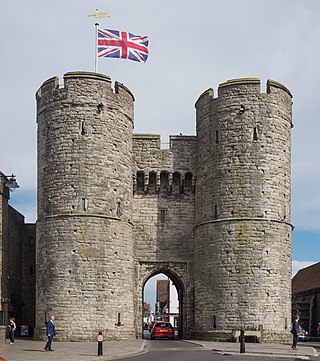
The Westgate is a medieval gatehouse in Canterbury, Kent, England. This 60-foot (18 m) high western gate of the city wall is the largest surviving city gate in England. Built of Kentish ragstone around 1379, it is the last survivor of Canterbury's seven medieval gates, still well-preserved and one of the city's most distinctive landmarks. The road still passes between its drum towers. This scheduled monument and Grade I listed building houses the West Gate Towers Museum as well as a series of historically themed escape rooms.

Warkworth Castle is a ruined medieval castle in Warkworth in the English county of Northumberland. The village and castle occupy a loop of the River Coquet, less than a mile from England's north-east coast. When the castle was founded is uncertain: traditionally its construction has been ascribed to Prince Henry of Scotland, Earl of Northumbria, in the mid-12th century, but it may have been built by King Henry II of England when he took control of England's northern counties. Warkworth Castle was first documented in a charter of 1157–1164 when Henry II granted it to Roger fitz Richard. The timber castle was considered "feeble", and was left undefended when the Scots invaded in 1173.

God's House Tower is a late 13th century gatehouse into the old town of Southampton, England. It stands at the south-east corner of the town walls and permitted access to the town from the Platform and Town Quay. It is now an arts and heritage venue, and has previously served as the town gaol and housed the Museum of Archaeology. The building is Grade I listed and a scheduled ancient monument.

Monk Street is an historic street in the town of Monmouth, Monmouthshire, Wales. A portion of it was in existence by the 14th century, and appears on the 1610 map of the town by cartographer John Speed. It runs in a north-south direction, extending northward from its intersection with Whitecross Street. The name of the street relates to the nearby Priory, as well as the gate which was originally on this road and provided part of the town's defences, Monk's Gate. Monk Street is lined with numerous listed buildings.

St Albans Town Hall, sometimes known as the Old Town Hall or The Courthouse, is a 19th-century building in St Albans, Hertfordshire, England. The building, which now accommodates the St Albans Museum, is a Grade II* listed building.

Gloucester Crown Court is a Crown Court venue which deals with criminal cases at Bearland, Gloucester, England. The court, which is located at the back of Gloucester Shire Hall, is a grade II listed building.
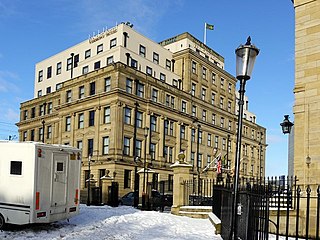
County Hall is a former municipal building, now a hotel, in Castle Garth, in Newcastle upon Tyne, England. The county hall, which was the headquarters and meeting place of Northumberland County Council from 1910 to 1981, is a Grade II listed building.

The Old Town Hall is a historic town hall in Market Place in Pontefract, West Yorkshire, England. It was completed in 1785 and was replaced by Pontefract Town Hall which was completed in 1882. It was designated a Grade II* listed building in 1950.
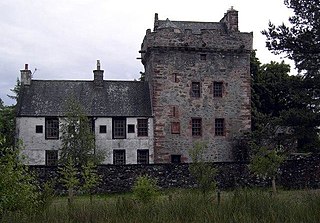
Hills Tower is a sixteenth-century square tower house, with an adjoining eighteenth-century wing, near Dumfries in Scotland. Originally built around 1527 for Edward Maxwell, who had purchased the estate from James Douglas of Drumlanrig, it was improved in the later sixteenth century by his grandson, also Edward Maxwell. In 1721, another Edward Maxwell had a two-storey Georgian wing added to the tower's east side, using stone taken from older buildings nearby, and incorporating armorial panels celebrating members of the Maxwell family.

Stamford Town Hall is a municipal building in St Mary's Hill, Stamford, Lincolnshire, England. The building, which was the headquarters of Stamford Borough Council, is a Grade II* listed building.

The Old Town Hall, sometimes referred to as the Moot Hall, is a municipal building in Church Street, Clitheroe, Lancashire, England. The structure, which was the meeting place of Clitheroe Borough Council, is a Grade II listed building.

The Queen's Hall, formerly Hexham Town Hall, is a municipal structure in Beaumont Street, Hexham, Northumberland, England. The structure, which was the headquarters of Hexham Urban District Council and is now an arts centre, is a Grade II listed building.

Newbrough Town Hall is a municipal building in Stanegate in Newbrough, Northumberland, England. The building, which is used as a community events venue, is a Grade II listed building.

Corbridge Town Hall is a municipal building in Princes Street in Corbridge, Northumberland, England. The building, which is now in commercial use, is a Grade II listed building.

Morpeth Court is a former judicial structure on Castle Bank, Morpeth, Northumberland, England. The structure, which used to be the entrance block for a prison as well as the main courthouse for the area, is a Grade II* listed building.

